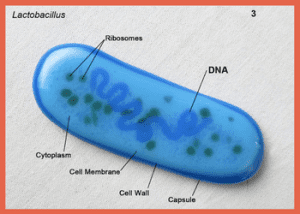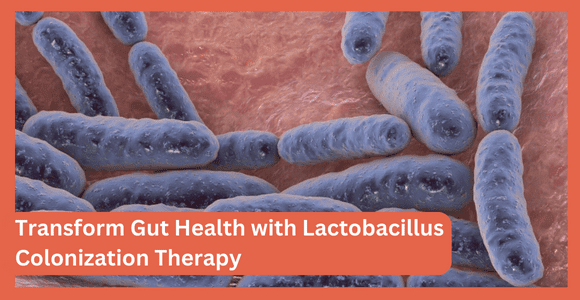The microbiome of the human gut holds a key role in keeping our health and prosperity. Imbalances in this microbiota, known as dysbiosis, have been found to cause multiple diseases including obesity and type 2 diabetes as well as inflammatory bowel disease.
A possible way to restore balance is through Lactobacillus colonization therapy- these bacteria produce lactic acid which is already present in us humans naturally.
Evidence reveals that colonization of Lactobacillus offers a plethora of health advantages, from strengthening the digestive system to boosting immunity and impeding the growth of unhealthy bacteria.
This article will explore how this therapy can revolutionize gut wellness and provide insight into its scientific substantiation as well.
Table of Contents
What is Lactobacillus?
Lactobacillus, a prolific bacterium found in the human body, chiefly in our guts and vaginas, is known for its transformation of sugars into lactic acid.
This process creates an acidic atmosphere that thwarts bad bacteria growth and defends your health. Not only utilized for the production of food items like yogurt and sauerkraut, but Lactobacillus probiotic strains can also be found in many probiotic supplements due to their potential health advantages.
Lactobacillus Crispatus Treatment
Lactobacillus crispatus is a specific strain of lactobacillus bacteria that is commonly found in the healthy vaginal microbiota of premenopausal women. The vaginal microbiota plays a crucial role in maintaining vaginal health by preventing the overgrowth of harmful microorganisms.
A depletion of lactobacilli, including L. crispatus, can lead to bacterial vaginosis treatment, which is characterized by a crispatus overgrowth of anaerobic bacteria.
 BV is a common gynecological condition that affects women of all ages, but it is most prevalent in reproductive-age women.
BV is a common gynecological condition that affects women of all ages, but it is most prevalent in reproductive-age women.
BV is associated with several adverse health outcomes, including an increased risk of sexually transmitted infections, pelvic inflammatory disease, and preterm birth.
Colonization by L. crispatus is associated with a lower frequency of BV, and L. crispatus is strongly correlated with the absence of BV, low pH, negative whiff test, absence of clue cells, and normal vaginal discharge.
The protective effect of L. crispatus against BV is thought to be due to its ability to produce lactic acid, which helps maintain a low pH in the vagina, making it difficult for harmful bacteria to thrive.
Additionally, L. crispatus produces hydrogen peroxide, which has antimicrobial properties and further contributes to the vaginal defense mechanism.
Antibiotic treatment is recommended for BV, but alternative remedies such as probiotics are also of interest due to problems with antibiotic resistance and the potential for adverse effects associated with antibiotic use.
Several studies have investigated the use of L. crispatus supplement for the prevention and treatment of BV. Results have been promising, with several studies reporting a reduction in the recurrence of BV following treatment with L. crispatus probiotics.
However, it is important to note that the effectiveness of L. crispatus probiotics may be strain-specific, meaning that not all L. crispatus strains may have the same beneficial effects. Furthermore, the optimal dose and duration of treatment with L. crispatus probiotics have not yet been established, and further research is needed to determine the safety and efficacy of this treatment modality.
Frequently Asked Questions
How to Increase Lactobacillus Crispatus?
One way to increase Lactobacillus crispatus is by consuming foods or supplements that contain this specific strain of probiotics. Additionally, maintaining a healthy and balanced vaginal pH through practices such as avoiding douching and using gentle cleansers can also promote the growth of Lactobacillus crispatus.
Can Lactobacillus Cure BV?
For two months, taking acidophilus or Lactobacillus rhamnosus GR-1 and Lactobacillus fermentum RC-14 resulted in the healing of bacterial vaginosis (as determined by having a 0-1 positive score according to Amsel’s criteria), prevented recurrences, and increased vaginal lactobacilli levels while restoring normal microbiota.
Which Lactobacillus is Best for BV?
Lactobacilli-based probiotics such as Lacticasebacillus rhamnosus, Lactobacillus acidophilus, Lactobacillus fermentum, and Lactobacillus reuteri are best for bv treatment.
How Do You Treat Lactobacillus Overgrowth?
To reinstate a balanced vaginal pH and grow the number of beneficial lactobacilli, baking soda (or sodium bicarbonate) therapies can be utilized. In addition to this therapy, abstaining from potential triggers may also prove advantageous in achieving our goal.
What is Lactobacillus Treatment?
Lactobacillus is an effective remedy for a variety of diarrheal illnesses, from rotaviral diarrhea that affects children to traveler’s diarrhea. Additionally, it can be used as a preventative measure against antibiotic-associated loose bowel movements.
Conclusion
Ultimately, Lactobacillus colonization therapy has great potential to restore gut microbiome balance and improve overall well-being. The various advantages of this approach have been thoroughly researched and include improved digestion, optimized immune system functioning, plus prevention against numerous pathogens.
Further research is needed to completely comprehend the workings of Lactobacillus colonization therapy, but the existing data indicate that it could be a safe and effective way for improving gut health. With so many people dealing with dysbiosis-related issues, this promising intervention has incredible potential in ameliorating overall gut well-being – making further exploration essential.
